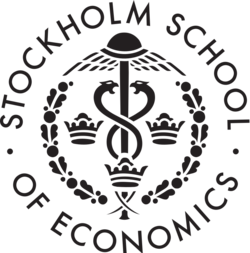Stockholm School of Economics
(University) | |
|---|---|
 | |
| Formation | 1909 |
| Headquarters | Stockholm, Sweden |
| Type | Private |
| Member of | Wallenberg Sphere |
| Swedish business school mostly funded by the Wallenebergs | |
The Stockholm School of Economics is a private business school located in city district Vasastaden in the central part of Stockholm, Sweden. SSE offers BSc, MSc and MBA programs, along with PhD- and Executive education programs. [1]
The school is the only privately funded university in Sweden. 82 percent of the funding comes from the Stockholm School of Economics Association, founded in 1906, and mostly from the large Swedish business families (mostly Wallenberg, some Bonnier and others).[2] 18 percent of the funding is public.[3]
SSE is accredited by EQUIS and is a member of CEMS.
SSE has founded sister organizations: SSE Riga in Riga, Latvia, and SSE Russia in St Petersburg and Moscow, Russia. It also operates the European Institute of Japanese Studies (Japanese, a research institute in Tokyo, Japan.
History
The Stockholm School of Economics was founded in 1909 on private initiative as a response to rapid industrialization and a growing need for well educated businessmen and company managers and has maintained close ties with the business community ever since. The foundation followed a substantial donation in 1903 by Knut Agathon Wallenberg. The name handelshögskola (roughly "college of commerce") was a parallel to the German term Handelshochschule, used by a number of German institutions started in the years before, commencing with Handelshochschule Leipzig in 1898. The term högskola was at this time also established for specialised higher educational institutions outside the universities, such as the Royal Institute of Technology, (Kungl.) Tekniska högskolan, which bore that name from 1877.
While founded as a business school, the subject of economics featured prominently in the research and curriculum of the school from the beginning.
The most well known scholars of the Stockholm School of Economics are arguably the economists Eli Heckscher (professor of economics and statistics 1909–1929, professor of economic history 1929–1945), and Bertil Ohlin (professors of economics). Heckscher is also known as the founder of economic history as an independent academic discipline and his work Svenskt Arbete och Liv is a fundamental work within this subject.
Ohlin was also a leading figure within the school of doctrine with the same name, the so-called Stockholm school; a group of leading Scandinavian economists influenced by Knut Wicksell, most of them active in Stockholm, either at the Stockholm School of Economics or the Stockholm University College. This school of doctrine was to have a profound influence on post-WWII Swedish economic policy and the development of the modern Scandinavian Welfare state. Heckscher and Ohlin jointly developed the so-called Heckscher-Ohlin theory, the standard international mathematical model of international trade. Bertil Ohlin received the Nobel Prize in Economics in 1977 (shared with British economist James Meade). Other prominent members of the Stockholm school were the Stockholm University professor Gustav Cassel, who developed standard economic theory of Purchasing power parity and economist Dag Hammarskjöld, Secretary-General of the United Nations in New York City, United States.
The school is a full member of the Association of Professional Schools of International Affairs (APSIA), a group of schools of public policy, public administration, and international studies.
Employees on Wikispooks
| Employee | Job | Appointed | End | Description |
|---|---|---|---|---|
| Assar Lindbeck | A O Wallenberg Professor in National Economics and Banking Science | 1964 | 1971 | Attended Bilderberg/1984 |
| Staffan Burenstam Linder | Rector | 1986 | 1995 | Attended Bilderberg/1988 |
| Carl Johan Åberg | Chairman | 1991 | 2002 |
Alumni on Wikispooks
| Person | Born | Died | Nationality | Summary | Description |
|---|---|---|---|---|---|
| Gustaf Adolf | 22 April 1906 | 26 January 1947 | Sweden | Royalty Deep state operative | Swedish royal who probably could have played an important role in post war Europe had he not died in 1947 air crash. |
| Magdalena Andersson | 23 January 1967 | Sweden | Politician | Attended the 2016 Bilderberg as Swedish finance minister. Supporter of the Great Reset who was briefly Prime Minister of Sweden. | |
| Erik Belfrage | 13 April 1946 | 18 April 2020 | Sweden | Diplomat Banker Businessperson | Swedish diplomat and banker. Wallenberg associate. Attended the 2005 Bilderberg |
| Claes Dahlbäck | 6 June 1947 | Sweden | Businessperson | Swedish businessman, Goldman Sachs | |
| Lars Heikensten | 13 September 1950 | Sweden | Economist Central banker | Swedish central banker and Nobel Foundation | |
| Stefan Ingves | 23 May 1953 | Sweden | Economist Central banker | Governor of Sveriges Riksbank, the central bank of Sweden | |
| Axel Iveroth | August 1914 | 1993 | Sweden | Businessperson | Headed the Swedish Industrial Association for 20 years |
| Martin Kragh | 9 August 1980 | Sweden | Academic | Leader of the Swedish cluster of the Integrity Initiative | |
| Staffan Burenstam Linder | 13 September 1931 | 22 July 2000 | Sweden | Economist | Wallenberg Sphere Swedish economist and key figure in the Moderate Party. Bilderberg/1988. |
| Bertil Ohlin | 23 April 1899 | 3 August 1979 | Sweden | Politician Economist | Swedish economist and politician who attended 3 Bilderbergs up to the 1962 Bilderberg |
| Per Westerberg | 2 August 1951 | Sweden | Politician Businessperson | Minister for Industry and Trade from 1991 to 1994. Speaker of the Swedish Parliament 2006-2014. | |
| Lars Wohlin | 24 June 1933 | 24 September 2018 | Sweden | Politician Central banker Deep state operative | Governor of the central bank Sveriges Riksbank 1979-82. Attended all Bilderberg meetings those four years. |
| Anders Åslund | 17 February 1952 | Sweden | Economist Deep state operative | Quad Bilderberger, Integrity Initiative. Worked on the Russian demographic catastrophe in the 1990s. |